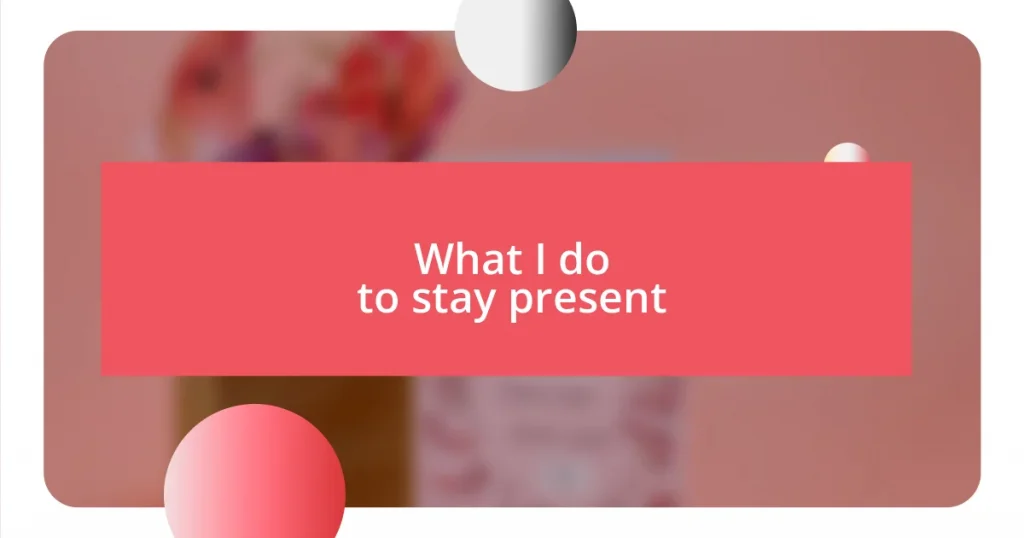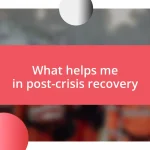Key takeaways:
- Being present enhances well-being, enriches relationships, and transforms interactions through mindful engagement.
- Common distractions include smartphone notifications, multitasking, and environmental noise, which can derail focus and productivity.
- Practicing techniques like mindful breathing, gratitude journaling, and sensory awareness fosters deeper connections and a more fulfilling life experience.
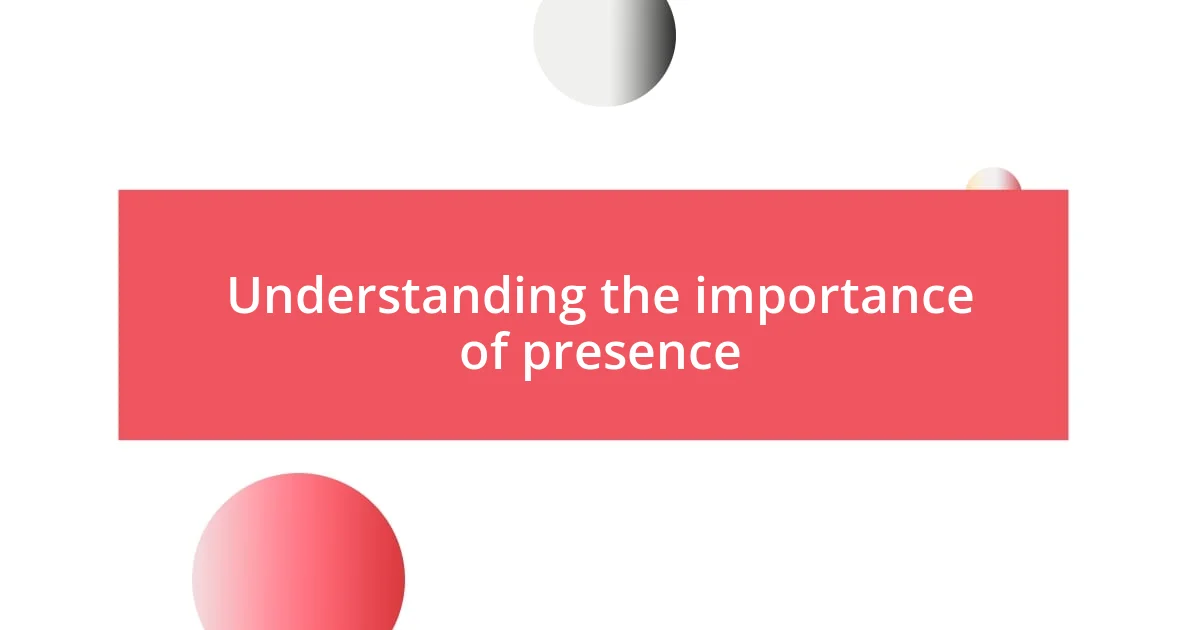
Understanding the importance of presence
Presence isn’t just a buzzword — it’s vital for our well-being. I remember a time when I was consumed with my to-do list, lost in thoughts about what was next. It hit me that I was missing out on simple moments, like my daughter’s laughter or the warmth of sunlight streaming through the window. Have you ever felt that nagging sense of rushing through life, only to realize later you’ve barely been there at all?
Being present enriches our experiences and enhances our relationships. I’ve found that when I genuinely focus on conversations, I connect with others on a deeper level. Often, I notice the subtle expressions on their faces or the sincerity in their voices, which brings a layer of intimacy to our interactions that’s often overlooked in the rush of daily life. Isn’t it fascinating how a simple shift in focus can transform our connections?
When I practice being present, I also calm my restless mind. I’ll sit quietly with my morning coffee, savoring each sip instead of scrolling through my phone. This small act grounds me and instills a sense of gratitude for the moment, igniting a ripple effect throughout my day. What if we all took a moment to just breathe, to anchor ourselves in the now? It could change not just our perspective, but our entire approach to life.
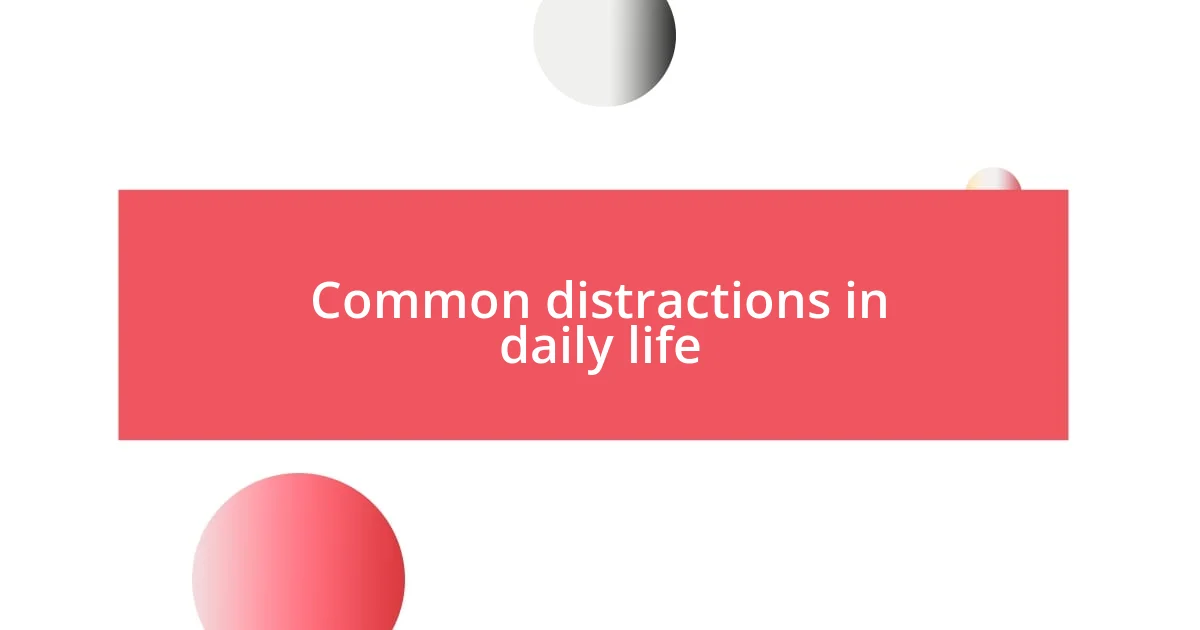
Common distractions in daily life
Distractions in our daily lives often creep in when we least expect them. Just the other day, I found myself sitting at my desk, fully intending to focus on my work, yet my mind was constantly interrupted by notification pings from my phone. I noticed how easy it was to lose precious minutes as I flipped through social media, completely derailing my productivity. Can you relate to this feeling of getting sidetracked by technology?
Another common distraction that I’ve encountered is multitasking. When I try to juggle multiple tasks at once, I end up doing just a bit of everything, but not doing any one thing well. I remember an afternoon when I attempted to cook dinner, help my son with his homework, and answer emails simultaneously. In the end, I burned the food, couldn’t assist my son effectively, and overlooked important messages. It’s a reminder that sometimes, less is indeed more.
Distractions can also emerge from our environment. For instance, whenever I work from home, the noise from outside can be relentless. I recall a day when lawnmowers and construction sounds invaded my workspace, disrupting my concentration entirely. I genuinely considered investing in noise-canceling headphones, emphasizing how crucial it is to create a focused environment to stay present. What about you? Have external noises ever pulled you away from your tasks?
| Common Distractions | Impact on Presence |
|---|---|
| Smartphone Notifications | Constant interruptions can divert attention from the present task. |
| Multitasking | Reduces efficiency and deep focus on any single task. |
| Environmental Noise | Can disrupt concentration and lower productivity significantly. |
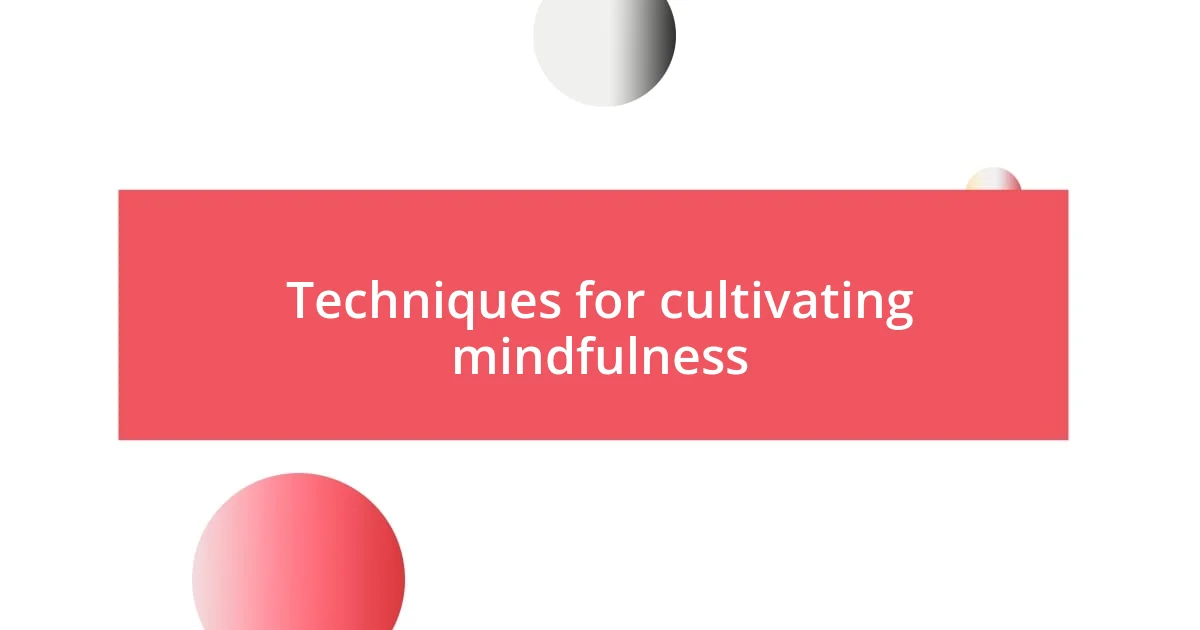
Techniques for cultivating mindfulness
Engaging in mindfulness techniques has truly transformed my daily life. One of my favorite practices is mindful breathing. I usually set aside just five minutes each morning to focus solely on my breath, noticing the way it moves in and out of my body. It’s incredible how this simple act can center my thoughts and alleviate feelings of stress.
Here are some techniques I’ve found effective for cultivating mindfulness:
-
Body Scan: I take a moment to consciously check in with each part of my body, acknowledging any tension or discomfort. It’s surprising how much I learn about myself in this process.
-
Mindful Walking: I love going for walks and paying attention to the sensation of my feet on the ground. It allows me to appreciate the world around me while grounding me in the present.
-
Gratitude Journaling: Each evening, I jot down three things I’m grateful for. This simple habit shifts my focus from what I lack to the richness of my life.
Practicing these techniques makes me feel more connected to my surroundings and enhances my overall sense of well-being. It’s like a breath of fresh air for my mind. What’s especially wonderful is that I have the power to choose happiness and presence at any moment.
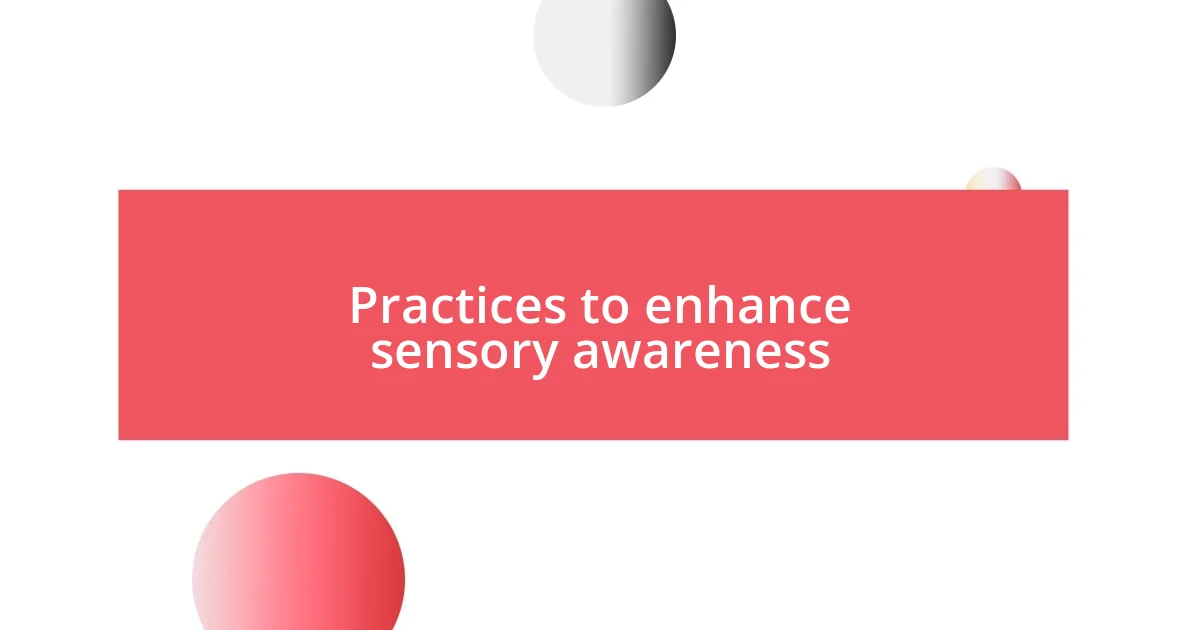
Practices to enhance sensory awareness
Focusing on sensory awareness can significantly enhance our connection to the present moment. One vivid practice I enjoy is savoring my meals. Eating slowly and mindfully, I truly notice the flavors, textures, and aromas of each bite. It’s fascinating how this simple act turns a mundane task into a delightful experience. Have you ever taken the time to really taste your food, rather than wolfing it down?
Another technique I’ve adopted is spending a few minutes each day outside, just listening. I find a quiet spot, close my eyes, and tune in to the symphony of nature—birdsong, rustling leaves, and even the distant hum of traffic. This practice not only sharpens my auditory skills but also brings a sense of peace and connection to the world around me. Does stepping outside ever evoke a sense of calm for you?
Touch is a powerful anchor in staying present, too. One of my favorite exercises is to hold a small object, like a smooth stone or a piece of fabric, and feel its texture. I focus on the details—its temperature, contour, and weight in my hand. This tactile awareness transports me away from distractions and into the here and now. Have you ever noticed how grounding a simple touch can be? It’s amazing how these sensory practices can transform our perception of reality and foster a deep sense of presence.
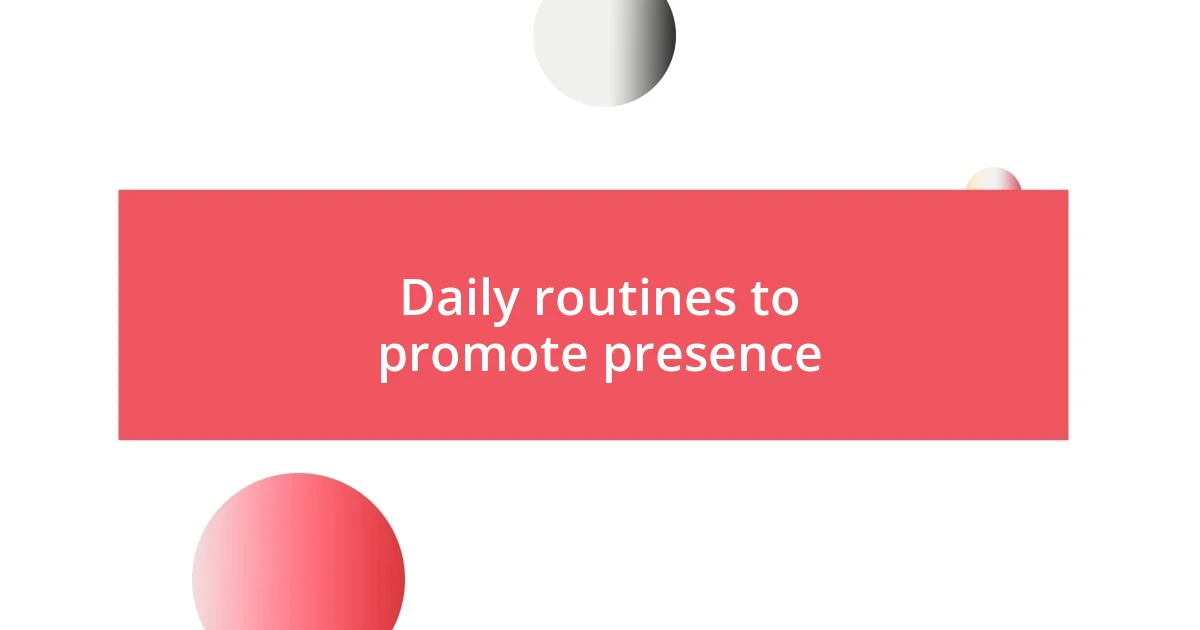
Daily routines to promote presence
Incorporating daily routines that promote presence has truly changed how I engage with life. One of my go-to practices is starting my day with a few minutes of stretching. As I stretch, I consciously pay attention to how my body feels and where I hold tension. This gentle reminder to reconnect with my body sets a mindful tone for the rest of my day. Have you noticed how stretching can awaken your senses?
A practice I often engage in is setting daily intentions. Each morning, I take a moment to identify one or two things I wish to focus on, such as kindness or creativity. This simple act of intention-setting gives my day a purpose, guiding my thoughts and actions. Have you ever noticed how clearly defining your focus can help you stay present amidst distractions?
In the evenings, I find solace in my tea ritual. As water simmers and the aroma fills the room, I truly immerse myself in the experience. I intentionally focus on each step—from boiling the water to savoring that first sip. This routine not only helps me unwind but also reinforces the importance of being present. Instead of rushing, I ask myself, “How does this moment feel?” Embracing these simple moments brings a profound joy that lingers long after the tea is gone.
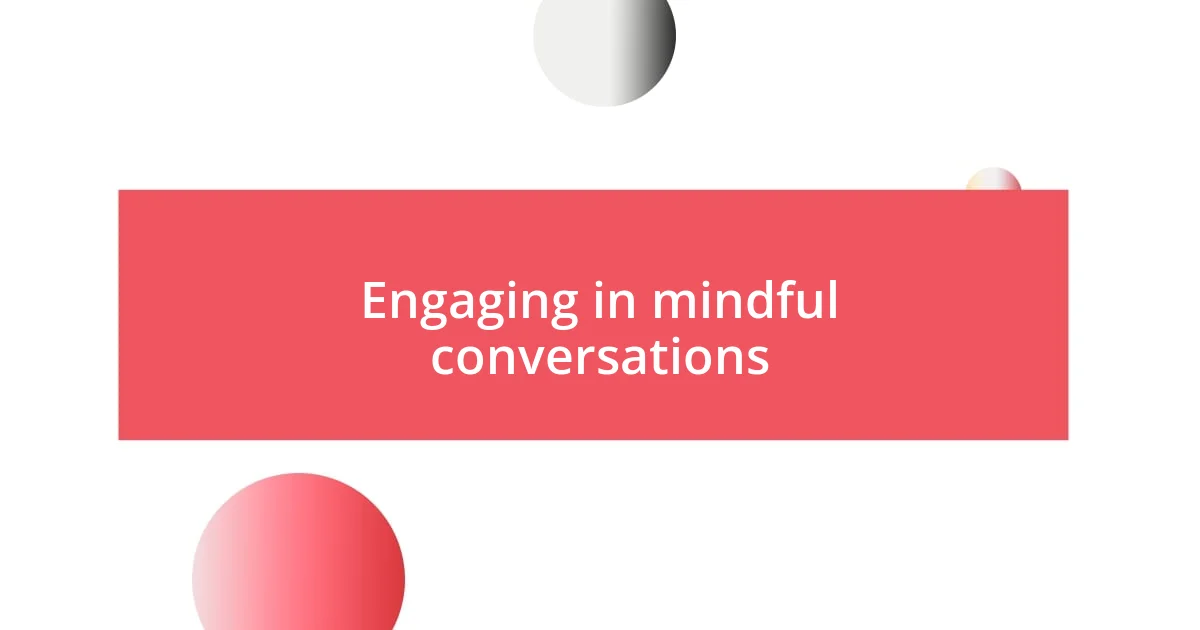
Engaging in mindful conversations
Engaging in mindful conversations has transformed my interactions with others. I make it a point to practice active listening, really focusing on what the other person is saying without letting my mind wander. I remember one time, during a catch-up with a close friend, I set aside my phone and just listened. It felt like a breath of fresh air to truly hear her thoughts without distractions. Have you ever noticed how much deeper a conversation can be when you’re all in?
I also find that asking open-ended questions fosters meaningful dialogue. Instead of defaulting to simple yes-or-no inquiries, I dive deeper by prompting further reflection, like asking, “What inspired that decision?” This not only enriches the conversation but shows the other person that I genuinely care and want to understand their perspective. It’s incredible how these small shifts can unlock a treasure trove of insights and make both parties feel valued. Isn’t it amazing how a well-placed question can unfold such layers of connection?
Finally, I believe body language plays a pivotal role in mindful conversations. I always try to maintain eye contact, nod, and offer genuine smiles to show my engagement. One memorable instance was during a workshop where I noticed how the facilitator’s energy shifted when we all leaned in and really connected through our expressions. That simple act of being present transformed the atmosphere, making it vibrant and full of life. Have you experienced how energetic the vibe can change when someone’s fully engaged with you?
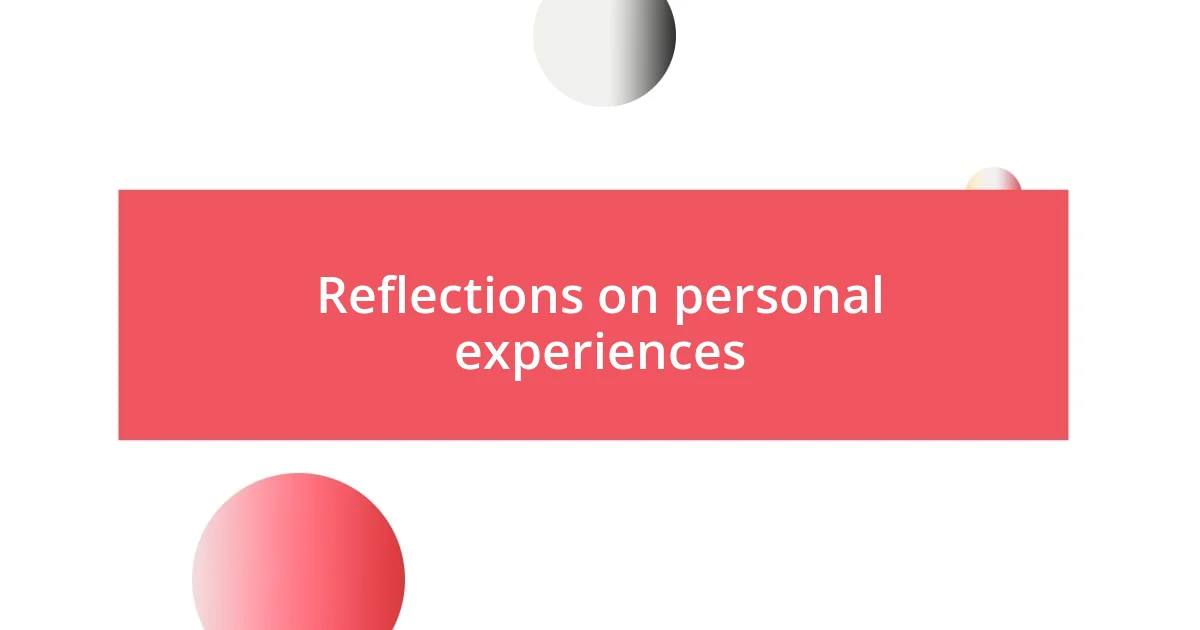
Reflections on personal experiences
Reflecting on my personal experiences, I often think back to a rainy afternoon when I decided to take a walk without my usual distractions. As I strolled through the park, the rhythmic sound of raindrops became a soothing backdrop, pulling me deep into the moment. Have you ever felt the way nature’s sounds can ground you and awaken your senses anew?
I remember an unexpected moment during a family dinner when I consciously put away my phone. Amid laughter and shared stories, I focused entirely on the conversations unfolding around me. The warmth in that room felt so much richer when I let go of distractions. It’s fascinating how just a small choice can amplify connection—don’t you think that makes our relationships more fulfilling?
Another memorable experience was my attempt at meditation during sunset. Sitting there, watching the vibrant colors dance across the sky, I noticed how quickly my racing thoughts began to settle. That simple act of being fully aware of the beauty around me brought a profound sense of peace. Isn’t it incredible how embracing each moment can lead to such clarity?










